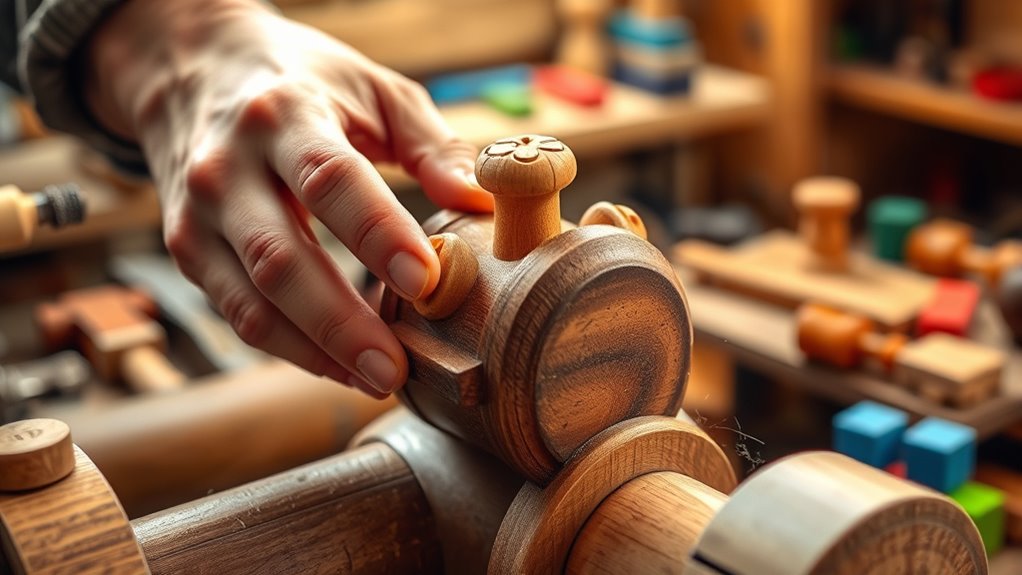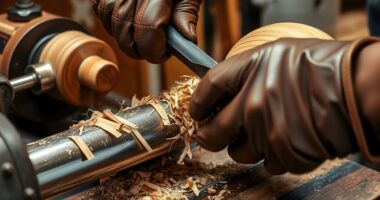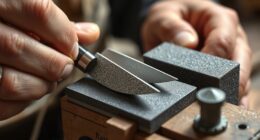To create wooden toys on a lathe, prioritize safety by wearing goggles and keeping tools sharp. Use versatile tools like gouges and skew chisels to shape and detail pieces such as wheels or figures. Maintain steady control with gentle movements, always cutting away from your body. Focus on craftsmanship and creativity by customizing designs and adding personal touches. With proper techniques and safety measures, you’ll craft unique toys that children will love—keep going to discover more tips!
Key Takeaways
- Use safe, age-appropriate tools and techniques to introduce children to woodturning creatively.
- Incorporate colorful paints and decorations to personalize wooden toys made on the lathe.
- Encourage children to design unique shapes and figures for imaginative toy creation.
- Focus on detailed, small parts like wheels or figurines to enhance craftsmanship and creativity.
- Maintain a safe workspace with proper supervision to foster a fun and educational environment.

Turning wooden toys on the lathe combines craftsmanship with creativity, allowing you to transform a simple block of wood into charming, functional toys. Before you begin, it’s essential to prioritize safety precautions. Working with a lathe involves spinning wood at high speeds, which can be dangerous if you’re not careful. Always wear safety goggles to protect your eyes from wood chips and dust, and use a dust mask to prevent inhaling particles. Keep loose clothing and jewelry away from the spinning parts, and tie back long hair. Never leave a running lathe unattended, and make certain your workspace is well-lit and free of obstructions. These safety measures aren’t just formalities—they’re your first line of defense as you craft.
Next, selecting the right tools is vital for a smooth and safe woodworking experience. Your primary tool will be the lathe itself, but don’t overlook the importance of choosing appropriate chisels and gouges. For toy making, you’ll want versatile, sharp tools like spindle gouges, skew chisels, and parting tools. Opt for high-quality, carbides or high-speed steel tools, which stay sharper longer and are easier to control. The right tool selection affects the quality of your finished toy and your safety, as dull tools require more force and can slip. Additionally, consider the size and shape of your tools—smaller, delicate tools give you more precision when shaping detailed parts like toy wheels or figures. Furthermore, understanding the contrast ratio of your tools can help you achieve smoother, more detailed surfaces on your toys. When you start turning, remember that tool control is key. Use steady, controlled motions, and always cut away from your body. Position your hands firmly but gently on the tool handles, maintaining a comfortable grip that allows for finesse rather than force. Regularly sharpen your tools to guarantee clean cuts and reduce the risk of slips, which could cause injury. Keep your workspace organized; a cluttered area increases the chance of accidents. As you become more experienced, you’ll develop a sense for which tools work best for different shapes and details, but initially, sticking to basic, well-maintained tools will give you safety and confidence.
Frequently Asked Questions
What Safety Gear Is Recommended for Children Using the Lathe?
You should guarantee children wear protective eyewear to shield their eyes from wood chips and dust. A dust mask is also essential to prevent inhaling fine particles during the turning process. Additionally, consider using gloves and hearing protection for extra safety. Always supervise children closely, making sure they understand how to handle the tools carefully. Safety gear helps keep their experience safe and fun while working on the lathe.
How to Choose the Right Type of Wood for Toy Making?
Imagine you’re choosing wood for a child’s toy. You want eco-friendly woods like maple or cherry, which have tight, attractive wood grain and are safe for children. These woods are durable and non-toxic, making them ideal. When selecting, look for smooth, splinter-free surfaces and avoid softwoods that may break easily. Prioritize sustainable sources to guarantee your toy is safe, eco-friendly, and built to last.
Can Children Operate a Lathe Independently?
Children cannot operate a lathe independently; they need supervision requirements to guarantee safety. You should always supervise children closely and provide age-appropriate tools designed for their size and skill level. It’s best to introduce lathe work gradually, starting with simple tasks and ensuring they understand safety rules. With proper supervision and suitable tools, children can develop their skills safely and enjoy creating wooden toys on the lathe.
How Do I Prevent Splinters During Toy Production?
To prevent splinters during toy production, always sand your wood thoroughly to smooth out rough edges and split points. Keep an eye out for signs of wood splitting and address them early. Applying a finish sealant helps create a protective barrier, reducing splinter risk over time. Wearing gloves and using sharp tools also improves control, ensuring your child’s safety while making their wooden toys.
What Are Some Beginner-Friendly Projects for Kids?
You might worry about your kids handling tools safely, but start with simple projects like making wooden animals or carved puzzles. These projects are beginner-friendly, requiring minimal experience and small tools. Kids can learn basic shaping and carving skills while creating fun, functional toys. Make sure to supervise closely and use child-safe tools. This way, they gain confidence and enjoy the creative process without feeling overwhelmed.
Conclusion
Now that you’ve mastered making wooden toys on the lathe, you’re practically a wizard of woodworking! Your creations aren’t just toys—they’re tiny masterpieces that could turn any child into the happiest, most imaginative person alive. With your newfound skills, you might just revolutionize playtime forever. So keep turning, carving, and dreaming—because your wooden toys are destined to become legendary, enchanting generations and making even the most stubborn kids giggle with pure joy!









